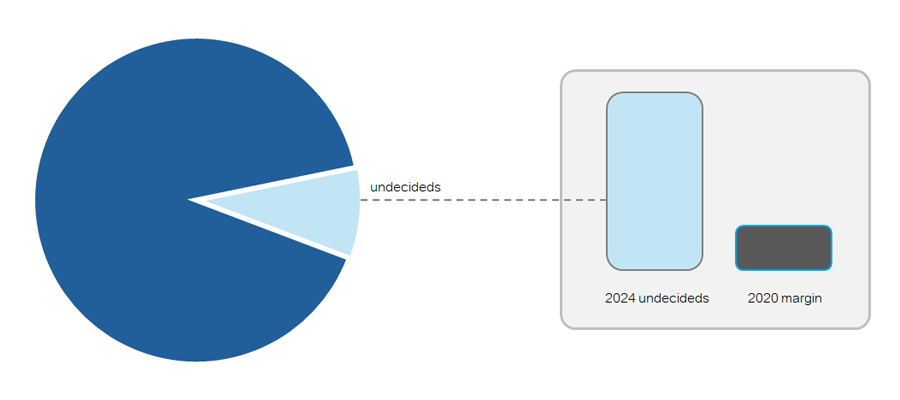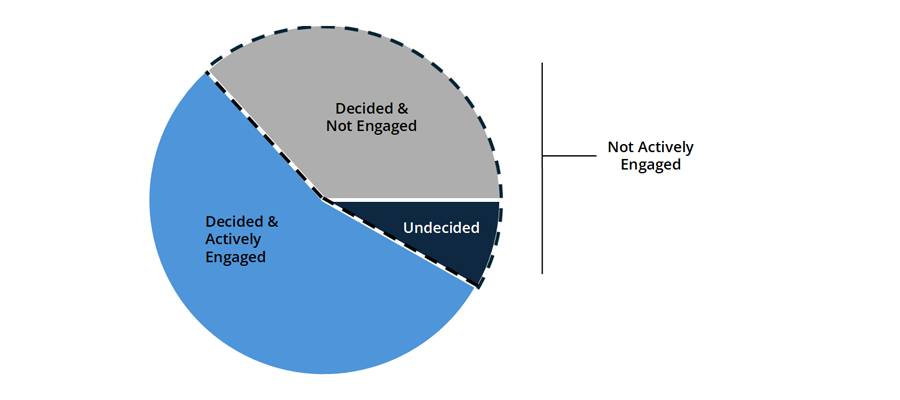Ah, the notorious ‘swing voter’.
There are 7.6 million voters in Michigan, a key battleground state. If we take the mid-range of 12.5%, then that’s 950K potential voters. That’s over 6 times Biden’s win margin in Michigan in the 2020 election.

It might seem far-fetched for most of us to learn that just 3 months out from the 2024 Election day, between 10-15% of registered voters are still undecided on who they will vote for. Depending on your perspective, that might seem like a small number or a lot. But here’s some context.
In an election year, where every person seems so dug in and polarized, it’s no wonder we get so focused on these ‘undecideds’.
If not on purpose, then clearly by their actions. One of the many confounding aspects of undecides is their consumption of campaign news. You might think that a person who is still undecided three months before a presidential election would try to get up to speed on some of the issues. That is just not the case though. More correct is that there is an inverse relationship between having decided who to vote for and consuming campaign-related news. Voters who have decided on their preference are 3-4 times more likely to say they are paying attention to campaign news than their undecided citizens. Undecideds simply do not pay much attention to what is going on politically.
You might think that because someone doesn’t know who they’ll vote for 100 days out from an election and doesn’t pay much attention to campaign news might not be worth paying much attention to. It would be reasonable to assume they probably won’t show up to vote anyway, right? Not so fast. Turnout research shows that, across the board, an undecided is around 30% less likely to show up than a firmly decided voter in the same age bracket.
Hmmm. Everyone from consultants to pundits to the campaigns themselves will point to how important it will be to reach the undecideds. The Harris campaign has built up a vast and expensive effort to reach these voters. The Trump campaign, at least in 2020, leaned more on social media and free media coverage and appears to follow the same playbook this time around.
We don’t yet know how effective the Harris or Trump campaigns will be in reaching these voters. We won’t know until after Election Day. However, swing voters and their importance to the campaigns is nothing new. So looking at 2020 should give a reasonable picture of how effective these campaigns are at reaching these voters. Spoiler alert: not very.
Over half (53%) of general election voters reported being involved in some campaign-supporting activity prior to Election Day. Those activities range from donating, to volunteering, to placing a candidate’s yard, and more. Of all voters, the breakdown of decided vs undecided and their corresponding involvement looks like this:

It would stand to reason that the majority of a campaign’s efforts would be focused on the undecides and voters not already actively involved. That would be a solid assumption. But wrong.
In fact, people who were already active moderately or very active in supporting a campaign (blue portion of the above graph) were contacted twice as much as inactive or non-voters. Further, inactive and undecided voters were over 2.5 times more likely to be completely ignored during the final weeks of the campaign.
As much ink that has been given to the campaigns’ vast efforts at sophisticated data tools and voter targeting, what seems to be more true is that we do a better job of repeatedly reaching those voters who are already in our camp.
Sources:
https://fivethirtyeight.com/features/just-how-many-swing-voters-are-there/
https://www.reuters.com/graphics/USA-ELECTION/INDEPENDENTS/lgpdnbxjzpo/
https://www.newsweek.com/whos-still-undecided-about-2024-profile-americas-persuadables-opinion-1916786
https://www.kff.org/other/issue-brief/data-note-swing-voters/
https://www.pewresearch.org/short-reads/2020/12/14/key-findings-about-voter-engagement-in-the-2020-election/
ProgressiveLabs is a Social Benefit Organization, dedicated to helping down-ballot Progressive organizations run effective, optimized campaigns that win on Election Day.